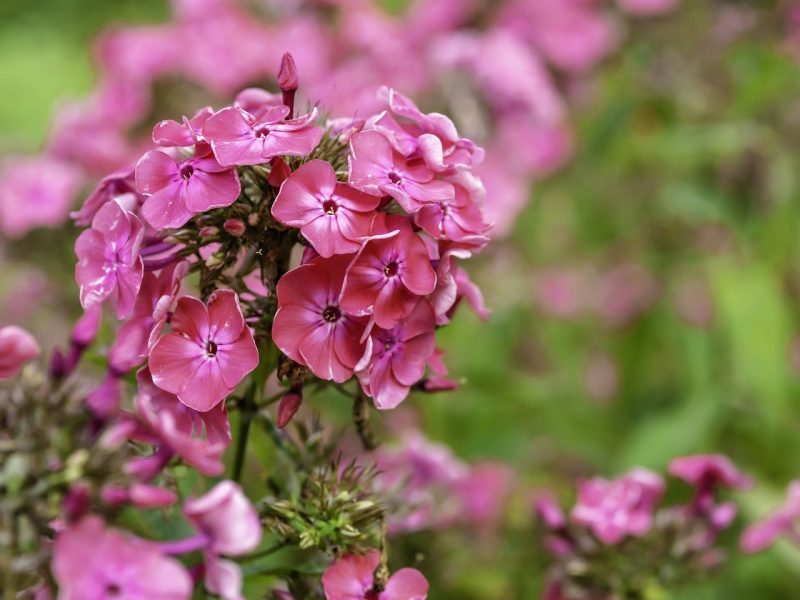There are two considerations when learning how to deadhead phlox. They are knowing when to deadhead phlox and the method of deadheading itself. More so, it’s worth noting that taking care of phlox does not start in propagation and ends in deadheading.
You also have to remember that every practice you do each day for phlox matters to ensure that they’ll thrive well. Since phlox is a large group of perennials, it would be best to know the specific caring requirements of the plant you have. And to make caring more comfortable, consider having them in the greenhouse to maintain the ideal conditions for these gorgeous flowering plants.

Comprehensive Guide On How To Deadhead Phlox
When to deadhead phlox
The University of Vermont recommends deadheading after your plants finished blooming, and as soon as you see blooms fading. This timing is also ideal because removing the spent flowers will help control the phlox population by keeping them from seeding. You may also want to deadhead as early as possible if your cold season arrives late.
This way, you can enjoy the continuous blooming of healthy flowers as the summer season is about to end. You can also time your deadheading depending on when you want a second bloom. For example, if your phlox bloomed in the middle of July, you can deadhead early in August, and this should result in another bloom before August ends.
How to deadhead phlox correctly
There are no special tricks when deadheading phlox. If you have experience with other flowering perennials, you can apply the same techniques. For example, start cutting the faded flower clusters with small scissors.
A quarter of an inch above the forming bud on the stem should be where you cut. You can also cut the entire flower stem if all the buds have faded to encourage new growth in the middle of the season. The space where the stem emerges from the plant is the ideal location to cut.
After you removed all the stems and flowers, make sure that you throw them away to prevent diseases. It’s better to compost them to avoid the risk of fungal spores that can infect phlox. Remember that this plant is prone to developing powdery mildew from poorly disposed spent stems and flowers.
Why Deadhead Phlox?
According to the University of Florida, cutting back foliage and removing spent flowers should encourage a second flowering after they bloom. This will also help create a denser growth and, as mentioned earlier, prevents seeding. Preventing phlox from setting seeds will elongate the flower display since they focus on blooming, and the practice also keeps them looking healthy and tidy.
How To Care For Phlox Year-Round
In general, you can simplify caring for phlox by maintaining soil moisture. Therefore, you need to regularly water your plants in the summer, especially if your area only has less than an inch of rain each week. Once spring comes, remember to add compost and mulch to keep the soil from drying while also keeping weeds at bay.
However, you also have to know some differences in caring for annual and perennial phlox. For example, perennial phlox thrives well in full sun and rich and fertile soil. On the other hand, annual phlox may require more watering, but still prefer rich soil and sunny location.
Annual phlox also don’t grow back, so it’s better to pull it out in the winter. You can then cut back the foliage of perennial phlox in the winter and mulch as it should grow back each year. Some phlox types like the tall phlox also benefit from cutting back after the first frost in fall.
What To Do With Dying Phlox?
Fungal diseases are the most common culprit of yellowing and drying phlox. Perhaps this is why watering diligence is crucial to prevent their spread and avoid creating an environment that is feasible for fungal growth. You can consider growing in the greenhouse as rain can encourage fungal diseases, especially with poor air circulation and infected soil.
Maintaining cleanliness, removing debris, proper spacing, and dividing overgrown phlox should help prevent diseases. You can also choose an area with slightly acidic soil and receives full sun to encourage healthy growth. And speaking of which, slow-release fertilizer should encourage healthy blooms and more vigorous plants.
Overall, prevention would be the best solution in conquering dying phlox. But if you did see the signs of diseases, it might be better to dig up the infected plants to prevent the spread of problems. You can also cut the dead portion and treat it with fungicide or insecticide, depending on the disease’s source.
Conclusion
One of the things we want for flowering perennials like phlox is to have an extended flower show. To do this, you need to learn how to deadhead phlox correctly. It’s a reasonably easy maintenance method to remove the spent flowers as soon as you notice them.
Afterward, safely dispose of the stems and flowers to prevent fungal diseases like powdery mildew. This simple practice of maintenance does not only encourage an extended blooming period or second flowering. It also helps to keep your plants looking tidy and prevent them from setting seeds.
